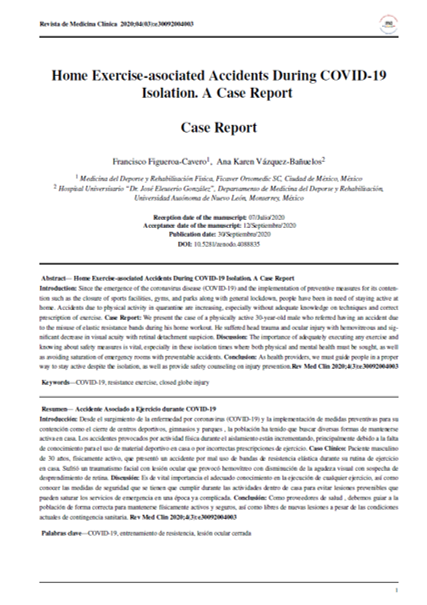Abstract
Introduction: Since the emergence of the coronavirus disease (COVID-19) and the implementation of preventive measures for its contention such as the closure of sports facilities, gyms, and parks along with general lockdown, people have been in need of staying active at home. Accidents due to physical activity in quarantine are increasing, especially without adequate knowledge on techniques and correct prescription of exercise. Case Report: We present the case of a physically active 30-year-old male who referred having an accident due to the misuse of elastic resistance bands during his home workout. He suffered head trauma and ocular injury with hemovitreous and significant decrease in visual acuity with retinal detachment suspicion. Discussion: The importance of adequately executing any exercise and knowing about safety measures is vital, especially in these isolation times where both physical and mental health must be sought, as well as avoiding saturation of emergency rooms with preventable accidents. Conclusion: As health providers, we must guide people in a proper way to stay active despite the isolation, as well as provide safety counseling on injury prevention.
References
World Health Organization. Coronavirus disease (COVID-19) Situation Report - 136. 04 June 2020. https://www.who.int/docs/default-source/coronaviruse/situation-reports/20200618-covid-19-sitrep-150.pdf?sfvrsn=aa9fe9cf_4
Weber J, Javelle F, Klein T, et al. Neurophysiological, neuropsychological, and cognitive effects of 30 days of isolation. Exp Brain Res. 2019;237(6):1563-1573. https://doi.org/10.1007/s00221-019-05531-0
Jacubowski A, Abeln V, Vogt T, et al. The impact of long-term confinement and exercise on central and peripheral stress markers. Physiol Behav. 2015;152(Pt A):106-111. https://doi.org/10.1016/j.physbeh.2015.09.017
Medic, G., Wille, M., & Hemels, M. E. (2017). Short-and long-term health consequences of sleep disruption. Nature and science of sleep, 9, 151. doi: 10.2147/NSS.S134864
Nyenhuis, S. M., Greiwe, J., Zeiger, J. S., Nanda, A., & Cooke, A. (2020). Exercise and Fitness in the age of social distancing during the COVID-19 Pandemic. The Journal of Allergy and Clinical Immunology. in Practice. https://doi.org/10.1016/j.jaip.2020.04.039
Jiménez-Pavón, D., Carbonell-Baeza, A., & Lavie, C. J. (2020). Physical exercise as therapy to fight against the mental and physical consequences of COVID-19 quarantine: Special focus in older people. Progress in cardiovascular diseases. doi: 10.1016/j.pcad.2020.03.009
Jurak, G., Morrison, S. A., LeskoÅ¡ek, B., KovaÄ, M., Hadžić, V., VodiÄar, J., ... & Starc, G. (2020). Physical activity recommendations during the COVID-19 virus outbreak. Journal of Sport and Health Science. doi: 10.1016/j.jshs.2020.05.003
American College of Sports Medicine. Guidelines for Exercise Testing and Prescription. 9th edition. 2014.
Bird, S. P., Tarpenning, K. M., & Marino, F. E. (2005). Designing resistance training programmes to enhance muscular fitness. Sports medicine, 35(10), 841-851. https://doi.org/10.2165/00007256-200535100-00002
Iversen, V. M., Mork, P. J., Vasseljen, O., Bergquist, R., & Fimland, M. S. (2017). Multiple-joint exercises using elastic resistance bands vs. conventional resistance-training equipment: A cross-over study. European journal of sport science, 17(8), 973-982. https://doi.org/10.1080/17461391.2017.1337229
Bergquist, R., Iversen, V. M., Mork, P. J., & Fimland, M. S. (2018). Muscle activity in upper-body single-joint resistance exercises with elastic resistance bands vs. free weights. Journal of human kinetics, 61(1), 5-13. https://doi.org/10.1515/hukin-2017-0137
Gray, S. E., & Finch, C. F. (2016). Assessing the completeness of coded and narrative data from the Victorian Emergency Minimum Dataset using injuries sustained during fitness activities as a case study. BMC emergency medicine, 16(1), 24. https://doi.org/10.1186/s12873-016-0091-4
SADLER Sports and Recreation Insurance. (Internet) Available from: https://www.sadlersports.com/blog/thousands-injured-in-gyms-and-at-home-in-pursuit-of-fitness/
Rosignoli, L. M., Regan, K. A., Gray, M. J., Ohning, C. R., & Iyer, S. S. (2019). Exercise band-induced lens dislocations: A case series. American journal of ophthalmology case reports, 15, 100496. https://doi.org/10.1016/j.ajoc.2019.100496
Sibley, D., Abdalla, H., Gupta, A., & Ho, J. (2020). Exercise in isolating during novel coronavirus 19-A case report of bilateral ocular trauma from elastic resistant bands. Canadian Journal of Ophthalmology. https://doi.org/10.1016/j.jcjo.2020.05.001
American College of Sports Medicine. ACSM’s health/fitness facility standards and guidelines. 4th ed. Champaign: Human Kinetics; 2012. Available from: https://books.google.com.mx/books?id=Du96DwAAQBAJ&lpg=PP17&ots=VuPPTadpwm&dq=16.%09American%20College%20of%20Sports%20Medicine.%20ACSM%E2%80%99s%20health%2Ffitness%20facility%20standards%20and%20guidelines.%204th%20ed.%20Champaign%3A%20Human%20Kinetics%3B%202012&lr&hl=es&pg=PP1#v=onepage&q&f=false
Serious Steel Fitness, LLC.Virginia: Pull up band guide; 2016.
Picha, K. J., Almaddah, M. R., Barker, J., Ciochetty, T., Black, W. S., & Uhl, T. L. (2019). Elastic resistance effectiveness on increasing strength of shoulders and hips. The Journal of Strength & Conditioning Research, 33(4), 931-943. doi: 10.1519/JSC.0000000000002216
Ramage, E. R., Fini, N. A., Lynch, E. A., Patterson, A., Said, C. M., & English, C. (2019). Supervised exercise delivered via telehealth in real time to manage chronic conditions in adults: a protocol for a scoping review to inform future research in stroke survivors. BMJ open, 9(3), e027416. doi: 10.1136/bmjopen-2018-027416
Pimlott, N., & Carson, J. (2014). Promoting exercise and preventing injury. https://www.cfp.ca/content/60/5/404

This work is licensed under a Creative Commons Attribution-NonCommercial-NoDerivatives 4.0 International License.
Copyright (c) 2020 Clinical Medicine Journal

